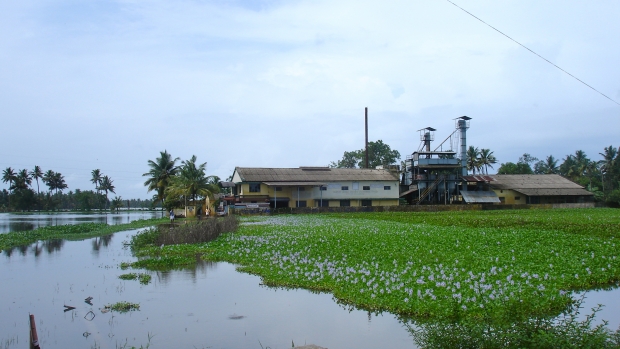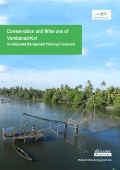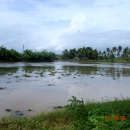Grants :: Small Grant Facilities :: Stakeholder led management planning for Vembanad Kol backwaters, Kerala
Stakeholder led management planning for Vembanad Kol backwaters, Kerala

Vembanad-Kol backwaters, Kerala, Vembanad-Kol backwaters, Kerala, India © Wetlands international - South Asia, 2012
Objectives
The project is aimed at developing a management planning framework for conservation and wise use of Vembanad-Kol backwaters as a means to support mainstreaming wetland ecosystem services and biological diversity into developmental planning and decision making processes. The objective of this project is to design an ecologically and socioeconomically sound ecosystem restoration programme for Vembanad Kol backwaters, Kerala.
Background
Vembanad-Kol constitutes one of the largest wetland regimes on the Malabar coastline. The wetland complex comprises Vembanad estuary flanked by river floodplains of Kuttanad and Kol, in south and north respectively interspersed by river estuaries and mangrove marshes which are interconnected by an intricate network of natural and manmade channels extending to over 1,780 km2. Spanning around 145 km along the coastline of Alappuzha, Ernakulam and Thrissur Districts, Vembanad-Kol wetlands form a part of the extensive chain of backwaters which are characteristic features of the state. The rich diversity supported by these wetlands is indicated by recorded presence of 147 plankton, 338 plant, 158 fish, and 225 bird species. Each year during winters, Vembanad-Kol harbours one of the highest populations of migrating waterbirds in the Central Asian Flyway within India. The wetland sustains livelihoods of nearly 0.2 million households through backwater tourism, inland navigation, and a range of resources as clams, shellfish and finfish. Located at the apex of the basin, Vembanad-Kol also regulates hydrological regimes, providing flood protection to large settlements as Cochin and Ernakulam as well as water for agriculture in the Kuttanad region – the Rice Bowl of Kerala. Vembanad – Kol was designated as a Wetland of International Importance (Ramsar Site) under the Ramsar Convention by the Ministry of Environment and Forests, Government of India in 2002. Vembanad Estuary and Kol Lands have been also identified as Important Bird Areas (IBA) of Kerala State. Mangalavanam, located on the eastern fringes of the wetland and a site of large waterbird congregation was declared as a Bird Sanctuary1 under the Wildlife Protection Act in 2004.
Lack of consideration of wetland ecosystem processes and its full range of ecosystem services and biodiversity values in regional developmental planning has led to rapid transformation of Vembanad-Kol, creating several adverse ecological and socioeconomic impacts.
Target beneficiaries
State Departments of Environment and Forests, and Animal Husbandry, Dairying and Fisheries
Tourism Sector (including Boathouse operators and owners)
Fishing and Aquaculture community
Agricultural community
Outputs
The output of this project is an Integrated Management Planning Framework for the Conservation and Wise-Use of the Vembanad Kol. The Kerala State Government is keen to carry out a similar exercise for a number of other wetlands in Kerala.
Accomplishments and challenges
Implementation of the regulatory framework is challenged. A formal structure for managing wetlands of Kerala is yet to emerge.
In August 2013, the Supreme Court took suo-moto cognizance of the fact that Vembanad Backwaters was “undergoing severe environmental degradation and there has been large scale encroachment and constructions going on in violation of the CRZ Notifications”, and directed the state government to identify all the CRZ violations around Vembanad backwaters and its islands. In July 25, The Kerala High Court ordered demolition of 59 villas and constructions on the island of Nediyathuruthu, near Cochin. Similarly, land use change analysis within Kuttanad indicates slow but increasing incidence of conversion of paddy lands for alternate uses. Discharge of untreated or partially treated industrial waste into rivers and water bodies continues unabated. Conserving mangroves has been equally challenging as they are located on lands with private titles.
Contributions to cross-cutting themes
The drivers and pressures that impact wetlands are numerous. This project aims to identify the threats and cumulative impacts of these threats, on the Vembanad Kol wetlands in Kerala, which support the livelihoods of hundreds.
Lessons Learned
The following are the key lessons and experiences with reference to establishing a wetland management institution for Vembanad Kol:
- Distinct institution for wetland management: The cross sectoral and multistakeholder needs for wetland management can be best served by designating a separate institution responsible for ensuring cross sectoral coordination and balancing interests of stakeholders while ensuring ecological integrity of the wetland system.
- Strategic planning and coordination function: Wetland authorities need to function as strategic planning and coordinating bodies maintaining an overview of the overall ecological state and trends and the drivers and pressures on wetland ecosystem within the wider landscapes as river basins and coastal zones. The capacity to implement interventions for ecological restoration is available within the respective departments, however, the wetland authorities need to provide the integrated cross –sectoral plans, evaluate implementation effectiveness and suggest mid-course corrections.
- Capacity and financing: The success of wetland authorities is closely related to availability of adequate human and financial resources to design and implement ecological restoration plans. Infrastructure for wetland monitoring and evaluation form a critical part of this capacity.
- Adaptable management: Wetland management institutions need to be adaptable to be able to work in ever changing ecological and socio-political landscapes. The success of management is linked to the ability to modify management based on a continuous evaluation of features and governing factors.
- Participation and awareness: The governance structure of wetland authorities should reflect the diversity of stakeholders influencing the state of wetlands. A mix of political, technical, administrative and civil society representation on the governing body enables better coordination and ensured sanctity to the management processes. The institutional mechanisms responsible for wetland management also need to create an enabling environment by enhancing awareness on wetland ecosystem services and biodiversity.
- Regulatory regimes: Wetlands are open systems and as such are exposed to a range of pressures including those from unsustainable use. In several circumstances, application of state acts and regulations provide a means to regulate these activities to ensure ecological integrity of wetlands. However, in wetlands which are intensively used for livelihoods and placed within a context of rapid urbanization and industrialization, wetland authorities need to be empowered with suitable regulation to ensure conservation and wise use.
Project Facts
Country
Location
Vembanad-Kol backwaters, Kerala, India
Topic
- Knowledge for Management
- Strategies for Management
- Reef to Ridge
- Monitoring, Learning and Evaluation
- Civil Society Engagement
- Capacity Building
- Sustainable Livelihoods
- Community Resilence
- Coastal Governance
- Integrated Coastal Planning
- Capacity development
- Climate change
- Gender equality
- Knowledge management and communications
Duration
28th Nov 2011 to 30th Nov 2012
MFF Grant Amount
INR 880,000
Co-financing Partner
Co-financing from Wetlands International-South Asia: INR 295,000
Implementing Partner
Mr. Ritesh Kumar
Conservation Programme Manager
Wetlands International - South Asia
ritesh.kumar@wi-sa.org
Related Images
Related Publications

Conservation and Wise use of Vembanad-Kol An Integrated Management Planning Framework
Wetlands International - South Asia SGF project - Final Report
Author: Wetlands International - South Asia
Publisher: MFF India
Posted on: 2nd Sep 2014
Category: SGF (Small Grant Facility)
Size: 5 MB

